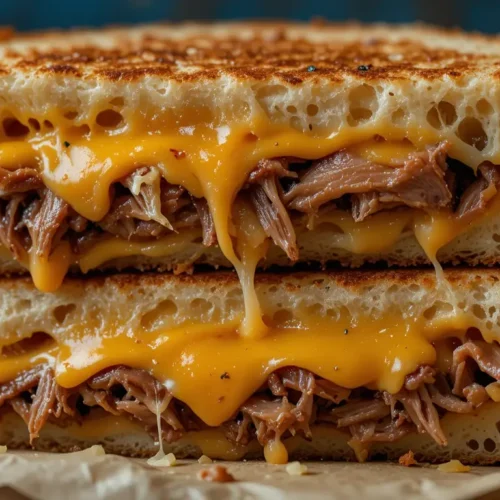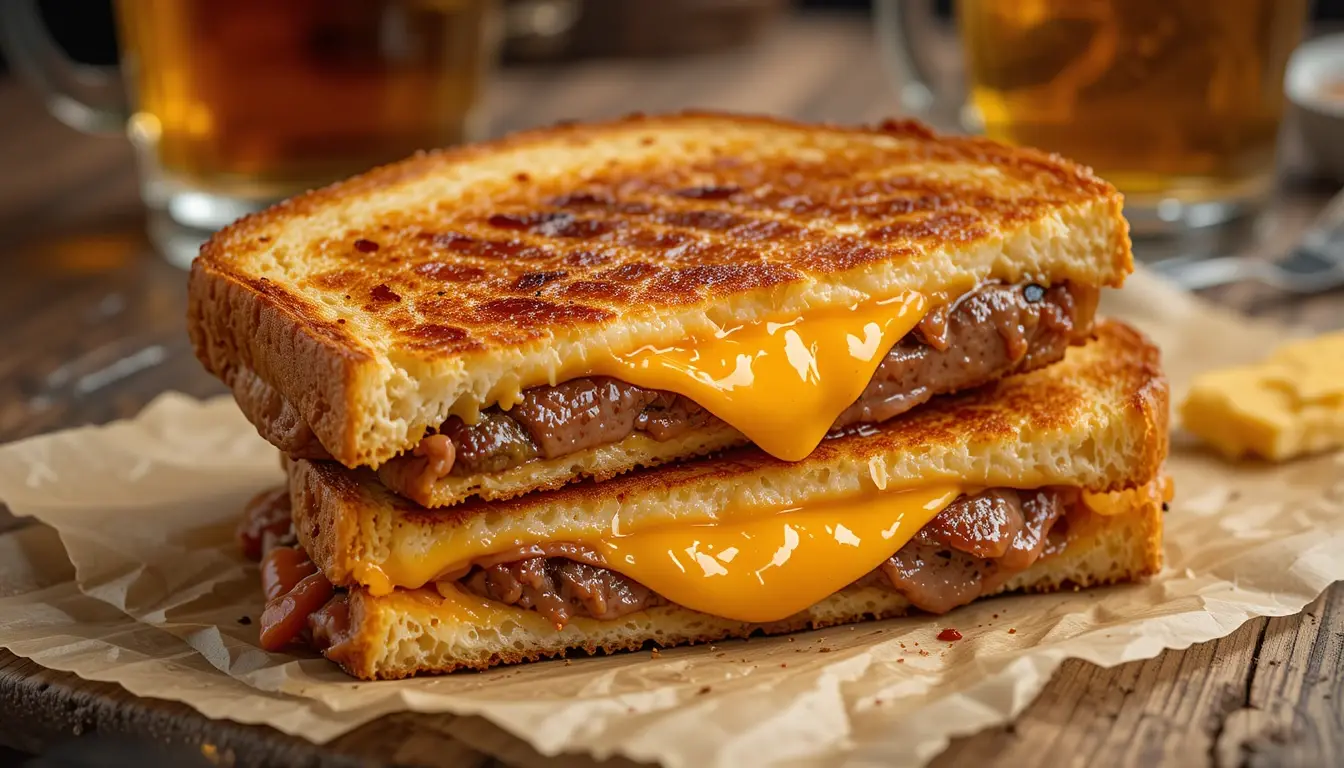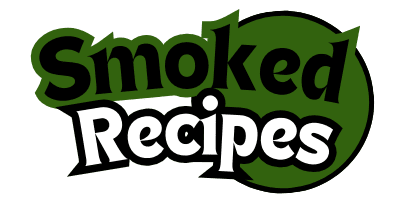Brisket grilled cheese is more than a sandwich it’s a moment. A tender bite of smoked brisket tucked between buttery, golden bread and melty cheese can turn a regular day into something worth savoring. If you’ve ever stood over a skillet, flipping a gooey grilled cheese with leftover brisket from last night’s smoke session, you already know the comfort this combo delivers. In this guide, I’ll show you exactly how I build mine, from cheese pairings to skillet tricks, plus variations you can try. We’re keeping it simple, bold, and true to what makes this recipe unforgettable.
Table of Contents
Brisket Grilled Cheese
My Brisket Grilled Cheese Obsession
The memory of first taste
I was in my tiny Asheville kitchen on a rainy October afternoon when the first version of this brisket grilled cheese came to life. I had just wrapped a supper club weekend, and there was leftover brisket resting in the fridge still smoky and tender, begging for a new life. I glanced at a loaf of thick Italian bread, pulled some sharp Cheddar and Monterey Jack from the cheese drawer, and got to work. Within minutes, the smell of butter, toasty bread, and warm brisket filled the room. That first bite? Crispy on the outside, melt-in-your-mouth inside. Pure magic.
Brisket grilled cheese quickly became one of those go-to comfort meals I never planned for but always craved. It taught me that some of the best cooking moments come from leftovers. And it’s a dish that doesn’t try too hard. It just works. If you’ve got good brisket, all you need is the right cheese and a hot pan.
Leftover brisket grilled cheese magic
There’s something sacred about leftover smoked meat. It holds all the flavor from the cook day especially if you followed a low and slow method, like the 3-2-1 rule for brisket. That’s why it shines in a grilled cheese. It’s already tender, already packed with smoky depth, and it breaks apart beautifully under heat.
For this recipe, I usually reach for slices of smoked Gouda when I want extra creaminess and warmth, or Cheddar for a punchier bite. Either way, the melted cheese grabs onto those brisket shreds and gives them new purpose.
Building the Best Brisket Grilled Cheese
Choosing the right cheeses for brisket grilled cheese
Not all cheeses are built for brisket grilled cheese. You need a mix of meltability and flavor something that won’t fade next to smoky, savory meat. That’s why I go with two kinds in every sandwich: one for stretch, one for sharpness. Monterey Jack gives you the gooey pull you want when you cut the sandwich in half. It melts fast, plays nice with others, and never competes. Then there’s Cheddar bold, salty, and deeply satisfying. A good sharp Cheddar doesn’t just melt; it blends right into the brisket and makes every bite better.
I’ve also tested this with Havarti, Provolone, and yes, even American cheese. They work in a pinch. But when I want balance, Cheddar and Monterey Jack win every time. And if you’re into smoky layers, slide in a thin piece of smoked Gouda for that extra depth. It adds just enough earthy sweetness without overpowering the star your brisket.
Shred your cheese instead of using slices. It melts faster and more evenly, wrapping every bite of meat and making the whole sandwich feel more intentional.
The bread matters more than you think
Now let’s talk bread. Soft sandwich slices won’t hold up here. Brisket is hearty, and so is cheese. You need a structure that crisps well and holds shape under pressure. That’s why I use Italian bread or thick-cut Texas toast. Both give you that perfect ratio of crunch to chew.
The bread is the canvas. If it’s too thin, it’ll get soggy. Too thick, and you lose the balance of textures. Go for slices about ¾-inch thick. They brown beautifully in a hot skillet and absorb just the right amount of butter without getting greasy.
And always butter the outsides, not the pan. This way, you control the crisp and avoid uneven browning. Want a little more flavor? Mix a pinch of garlic powder or smoked paprika into softened butter before spreading it on the bread. It adds subtle complexity without stealing the spotlight.

Brisket Grilled Cheese
Ingredients
- 8 slices Italian bread or Texas toast
- Butter for spreading
- 1 cup heaping shredded Cheddar cheese
- 1 cup heaping shredded Monterey Jack cheese
- 2 –3 slices leftover brisket shredded
Instructions
- Spread about 1/2 tablespoon of butter on one side of each bread slice.
- Place a slice of bread butter-side down on a board or plate.
- Add a layer of shredded Cheddar, followed by the brisket, then top with Monterey Jack cheese.
- Place a second slice of bread on top, buttered-side up.
- Repeat for remaining sandwiches.
- Heat a skillet (cast iron preferred) over medium heat.
- Cook sandwiches 3–4 minutes per side, until golden brown and the cheese is fully melted.
- Slice, serve hot, and enjoy.
Notes
- Use smoked Gouda for a creamier, smokier twist.
- Pickled onions or jalapeños can add extra flavor.
- Cold brisket is easier to shred and layer.
-
Nutritional Info (per serving):
- Calories: 520
- Fat: 32g
- Saturated Fat: 17g
- Unsaturated Fat: 12g
- Trans Fat: 0g
- Cholesterol: 90mg
- Sodium: 700mg
- Carbohydrates: 30g
- Fiber: 2g
- Sugar: 2g
- Protein: 28g
Crafting the Perfect Sandwich
Layering order and balance
Brisket grilled cheese doesn’t work unless the layers make sense. You want every bite to have equal parts crisp bread, gooey cheese, and smoky brisket. That means the way you stack things matters. I always start with a buttered slice of bread, butter-side down. From there, I sprinkle a generous layer of shredded Cheddar directly on the bread. This melts fast and anchors everything in place.
Next comes the brisket. If it’s leftover and cold, shred it by hand or chop it fine so it warms quickly and evenly. Don’t pile it too high roughly two to three slices worth. Spread it edge to edge, no empty corners. Then top with Monterey Jack, another heaping handful. This second layer of cheese locks the brisket in and gives you that creamy bite.
Finish with the second slice of bread, butter-side up. That’s your crispy lid. If you’re feeling adventurous, you can add a thin swipe of Dijon mustard or a slice of pickled jalapeño between the cheese and meat for some bite, but the base recipe doesn’t need anything more.
Griddling tips: skillet vs griddle
This sandwich needs even heat. I like using a cast iron skillet because it holds steady heat and builds a golden crust without burning the bread. Set it over medium don’t rush it. Too hot, and the bread scorches before the cheese melts.
Cook one or two sandwiches at a time. Press lightly with a spatula to seal everything together as it toasts. Let each side cook for about 3–4 minutes until it’s deep golden and the cheese has melted. You’ll know it’s ready when the sides start to ooze a little and the bread feels crisp to the touch.
If you’re cooking for a crowd, a flat griddle works too. Just give yourself space and keep an eye on hot spots. And don’t flip more than once it can make the structure collapse or cause uneven melting.
This method gives you the perfect balance of melted interior and crunchy exterior. A brisket grilled cheese that holds together, looks rustic, and tastes like a weekend well spent.
Brisket, Cheese, and Smoky Variations
Adding toppings without overpowering it
When it comes to toppings, less is more. Brisket grilled cheese already brings bold flavor adding the wrong extras can throw it off. But done right? A few toppings can deepen the experience without taking away from the star players.
Pickled red onions add tang and brightness. A few slices tucked between the cheese and meat wake up your palate. Thin-cut jalapeños (fresh or pickled) bring heat and contrast the richness of the cheese. Even a layer of caramelized onions works well if you’ve got time they offer sweetness that balances the brisket’s smoke.
Want crunch? Add a handful of crushed kettle chips or crispy fried onions just before assembling. They stay crisp for just long enough to surprise you in each bite. Just don’t go overboard this isn’t a loaded sandwich. It’s a focused, flavor-forward comfort food with a clear point of view.
Even a whisper of BBQ sauce can be tempting, but I’d recommend only a light brush if your brisket needs moisture. Too much and you’ll lose the cheese-and-meat harmony.

Regional twists and smoker secrets
If you’re already smoking brisket at home, you’ve got options. Use leftover meat from a best smoker recipe session and slice it thin while still cold it’ll reheat more evenly in the sandwich. You can also mix in brisket burnt ends for added texture and extra smoke punch.
In Texas, brisket grilled cheese often gets a hit of heat chipotle mayo or spicy mustard. In North Carolina, where I live, we lean toward a vinegar tang. I’ve seen versions with pimento cheese or even slivers of collards tucked in. All of them respect the brisket, letting it shine with small regional personality notes.
Smoked cheese fans might love playing with smoked Gouda or even a soft smoked blue. A little goes a long way, so blend it with a neutral melting cheese like Jack or Havarti to keep things balanced.
The best twist? Make it your own. Use what you’ve got, taste as you go, and don’t let the rules box you in.
Conclusion About Brisket grilled cheese
Brisket grilled cheese is everything I love about cooking simple, soulful, and built from leftovers that somehow taste better the second time around. There’s no need for fancy ingredients or long prep. Just good bread, good cheese, and brisket that still carries the smoke from yesterday’s fire. It’s the kind of meal that hits the spot on a slow weekend, a chilly night, or when you’re just craving something warm, melty, and deeply satisfying.
Once you’ve made it, you’ll keep coming back to it. The crunch of the bread, the pull of the cheese, the richness of the brisket it never gets old. Whether you’re experimenting with toppings or sticking to the basics, this sandwich reminds you that the best meals don’t need a lot. Just a little care and the right skillet heat.
For more recipes follow me in Facebook
FAQ Section About Brisket grilled cheese
What kind of cheese goes well with brisket?
The best cheeses for brisket are ones that melt well and complement, not compete with, its smoky richness. Sharp Cheddar offers bold flavor and a nice contrast to the brisket’s fat. Monterey Jack is a smooth, creamy option that blends seamlessly. For extra smokiness, smoked Gouda or Provolone can be layered in moderation. If you’re experimenting, try a mix sharp for flavor, soft for melt. Just avoid anything too mild or watery, as it can make the sandwich soggy or bland. Always shred your cheese fresh to help it melt quickly and evenly with the brisket.
What is a brisket grilled cheese?
A brisket grilled cheese is the marriage of smoked beef brisket and melted cheese between two golden slices of buttered bread. It’s the kind of sandwich that turns leftovers into comfort food magic. The key is balance: slow-cooked brisket layered with gooey cheeses, then toasted until crispy on the outside and melty inside. Unlike a regular grilled cheese, the brisket version adds depth and richness thanks to the meat’s smoke, fat, and texture. It’s often built with thick bread like Texas toast and can be customized with toppings like onions or jalapeños.
What toppings go on a brisket sandwich?
Toppings can take your brisket sandwich from good to unforgettable as long as they don’t overwhelm the meat. Classic options include pickles, caramelized onions, and coleslaw. For grilled cheese versions, lighter toppings work better: pickled red onions for brightness, sliced jalapeños for heat, or a small swipe of BBQ sauce for moisture. Crispy elements like fried onions or even potato chips add a fun crunch. The goal is to amplify the brisket’s flavor, not mask it. If your brisket is well-smoked and juicy, keep the toppings minimal and let the meat lead.
What is the 3-2-1 rule for brisket?
The 3-2-1 method is a common smoking technique mostly used for ribs, but some pitmasters apply its rhythm to brisket. It means smoking for 3 hours unwrapped, 2 hours wrapped in foil or butcher paper to retain moisture, then 1 hour unwrapped to firm up the bark. While brisket usually needs longer overall (often 10–14 hours depending on size), the concept of cycling through wrapped and unwrapped phases helps control bark texture and tenderness. For brisket grilled cheese, using leftover meat from a 3-2-1 style smoke ensures your brisket is already tender and flavorful.

